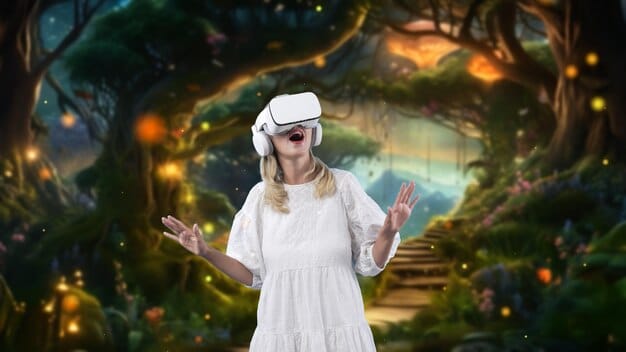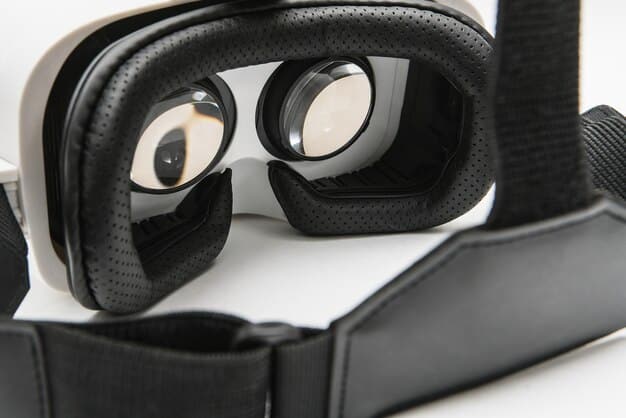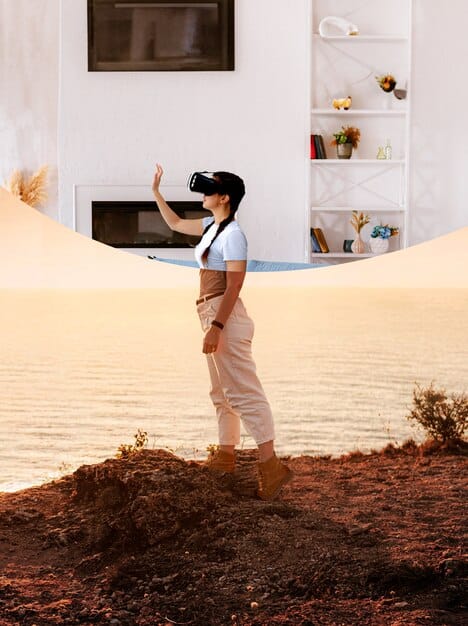Inside-Out vs. Base Station VR Tracking: Which Is Best in 2025?

Inside-out tracking and base station tracking are the two primary methods used in VR to determine a user’s position in space; in 2025, the best accuracy depends on specific needs, with inside-out offering more convenience and base station potentially providing higher precision.
Choosing the right VR tracking system is crucial for an immersive and accurate virtual reality experience. In 2025, the debate between inside-out tracking vs. base station tracking: which VR system offers the best accuracy? continues to shape the landscape of VR hardware. Let’s dive into a detailed comparison.
Understanding VR Tracking Technologies
Virtual reality tracking is the backbone of any VR system, allowing the headset and controllers to accurately represent your movements within the virtual environment. Understanding the two primary technologies, inside-out and base station tracking, is essential for choosing the system that best fits your needs.
What is Inside-Out Tracking?
Inside-out tracking uses sensors on the VR headset itself to track its position and orientation in space. These sensors typically include cameras that capture the environment around the user, using visual features to determine movement.
What is Base Station Tracking?
Base station tracking, on the other hand, utilizes external devices (base stations) that emit infrared light to track the position of the headset and controllers. Sensors on the headset and controllers pick up this light, allowing the system to calculate their precise location.

Both methods have their strengths and weaknesses, which we’ll explore in more detail in this article.
How Inside-Out Tracking Works
Inside-out tracking has become increasingly popular due to its convenience and ease of use. Let’s take a closer look at how this technology works and its underlying components.
Key Components of Inside-Out Tracking
The core of inside-out tracking lies in the following components:
- Cameras: Typically, multiple cameras are mounted on the headset, providing a wide field of view.
- Sensors: Inertial Measurement Units (IMUs) help track rotational movements.
- Software Algorithms: These algorithms process the data from the cameras and sensors to determine the headset’s position and orientation.
The Tracking Process
The process unfolds as follows:
- The cameras capture images of the environment.
- The software identifies unique features in the images.
- IMUs track the headset’s rotation.
- The system combines this data to calculate the headset’s position and movement.
This eliminates the need for external sensors, making it more portable and user-friendly.
Inside-out tracking offers a seamless setup experience and greater flexibility in terms of play space. It is continually improving, bringing enhanced accuracy to VR experiences.
How Base Station Tracking Works
Base station tracking remains a highly accurate and reliable method for VR tracking. Understanding its mechanics is crucial for appreciating its precision.
Key Components of Base Station Tracking
The main components include:
- Base Stations: These devices emit infrared light across the play area.
- Sensors on Headset/Controllers: These detect the infrared light from the base stations.
- Processing Unit: This calculates the precise position of the headset and controllers based on the infrared light received.
The Tracking Process
The process works as follows:
- Base stations emit sweeping lasers across the room.
- Sensors on the headset and controllers detect these lasers.
- The timing of the laser sweeps is used to determine the exact position.
- This data is processed to provide highly accurate tracking.
While setup can be more involved, the precision often justifies the effort for enthusiasts seeking the best possible tracking accuracy.
Base station tracking is known for its robustness and is particularly suited to larger play spaces, offering unparalleled tracking fidelity.
Accuracy Comparison: Inside-Out vs. Base Station
Accuracy is a critical factor when choosing a VR tracking system. Both inside-out and base station tracking have made significant strides, but some differences persist.
Factors Affecting Accuracy
Several factors influence tracking accuracy:
- Environmental Conditions: Lighting, reflective surfaces, and occlusions can impact tracking performance.
- Sensor Quality: Higher-quality sensors provide more precise data.
- Algorithm Sophistication: Advanced algorithms enhance accuracy by reducing noise and errors in the tracking data.
Real-World Performance
In real-world scenarios:
- Inside-Out Tracking: Generally performs well in well-lit environments with varied visual features.
- Base Station Tracking: Maintains accuracy even in challenging lighting conditions or with fewer visual cues.

Recent advancements have narrowed the gap, but base station tracking often retains an edge in terms of raw precision.
Ultimately, the choice depends on the specific requirements of the application and the environment in which it will be used. For those prioritizing ease of use and portability, inside-out tracking presents a compelling option. For those needing the highest possible accuracy and willing to invest in a more complex setup, base station tracking remains a strong contender.
Pros and Cons of Each System in 2025
In 2025, both tracking systems have advanced significantly. However, they still come with their individual strengths and weaknesses.
Inside-Out Tracking: Advantages
The advantages are clear:
- Ease of Setup: No external sensors required; simply set up the headset and play, making it ideal for newcomers.
- Portability: Can be used in any environment without the need for pre-installed base stations.
- Cost-Effectiveness: Often more affordable compared to base station setups.
Inside-Out Tracking: Disadvantages
The disadvantages include:
- Environmental Dependency: Requires well-lit and visually rich environments for optimal performance.
- Occasional Occlusion: Tracking can be disrupted if hands or objects block the headset cameras.
- Accuracy Limitations: May not be as precise as base station tracking in certain scenarios.
Base Station Tracking: Advantages
The advantages are:
- Superior Accuracy: Provides highly precise tracking across a wide range of conditions.
- Robust Performance: Less susceptible to environmental factors like lighting.
- Scalability: Supports larger play spaces and multiple users.
Base Station Tracking: Disadvantages
The disadvantages are:
- Complex Setup: Requires installation and configuration of external base stations.
- Higher Cost: Base stations and compatible hardware can be expensive.
- Limited Portability: Not easily moved between different locations.
In 2025, choosing between these systems involves weighing the convenience of inside-out tracking against the precision of base station tracking, based on your specific needs and budget.
The Future of VR Tracking
The field of VR tracking is continuously evolving. Let’s explore some of the innovations that are likely to shape the future of this technology.
Advancements in Sensor Technology
Future sensors will be:
- More Precise: Enhanced resolution and accuracy for better tracking fidelity.
- More Compact: Smaller and lighter sensors for more comfortable headsets.
- More Robust: Improved resistance to environmental interference.
Improvements in Software Algorithms
Advanced algorithms will enable:
- Better Occlusion Handling: More intelligent prediction and compensation for occlusions.
- Improved Environmental Understanding: Enhanced ability to map and understand the surrounding environment.
- AI-Driven Tracking: Using machine learning to optimize tracking performance.
These advances will lead to more seamless and immersive VR experiences, regardless of the tracking method used.
The future of VR tracking promises to blend the best aspects of both inside-out and base station technologies, creating a hybrid approach that offers unmatched accuracy and convenience.
| Key Point | Brief Description |
|---|---|
| 💡 Inside-Out Tracking | Uses headset cameras for position tracking, no external sensors needed. |
| 📡 Base Station Tracking | Employs external devices emitting IR light for high-precision tracking. |
| 🎮 Accuracy Factors | Environment, sensor quality, and algorithms affect tracking performance. |
| 🔮 Future Trends | Advancements in sensors and AI will improve tracking for both systems. |
Frequently Asked Questions
▼
Inside-out tracking uses sensors on the VR headset to determine position, while base station tracking uses external devices emitting infrared light. This fundamentally changes setup and usage.
▼
Base station tracking tends to maintain accuracy in a wider range of environmental conditions compared to inside-out tracking, particularly in dimly lit areas.
▼
Yes, inside-out tracking is significantly more convenient for portable setups because it eliminates the need for external sensors and base stations, enhancing mobility.
▼
Advancements lead to more precise, compact, and robust sensors that improve tracking fidelity and comfort, reducing environmental dependency and enhancing overall performance.
▼
AI enhances VR tracking by optimizing performance through machine learning, improving occlusion handling, and enabling a more sophisticated understanding of the environment for better accuracy.
Conclusion
In 2025, determining whether inside-out tracking or base station tracking offers the best accuracy depends on individual needs and priorities. Inside-out tracking provides convenience and ease of use, ideal for portable setups, while base station tracking continues to deliver superior accuracy and robustness in more controlled environments. The future promises a hybrid approach, combining the strengths of both for an optimal VR experience.





